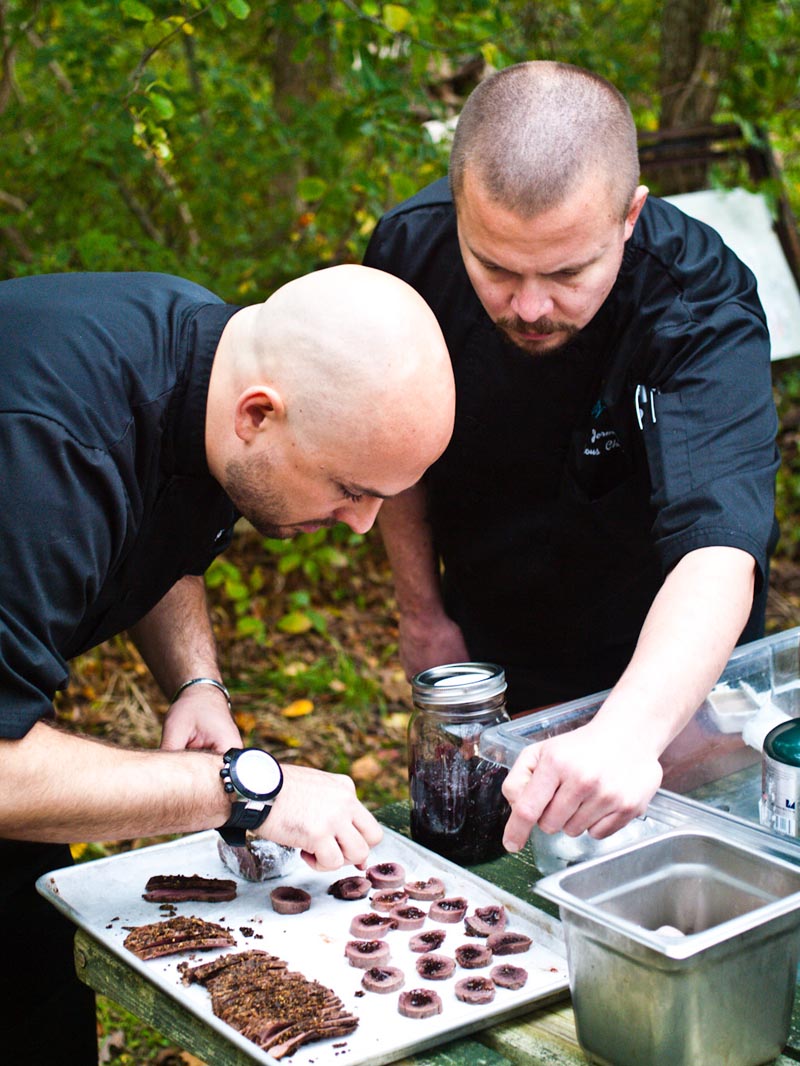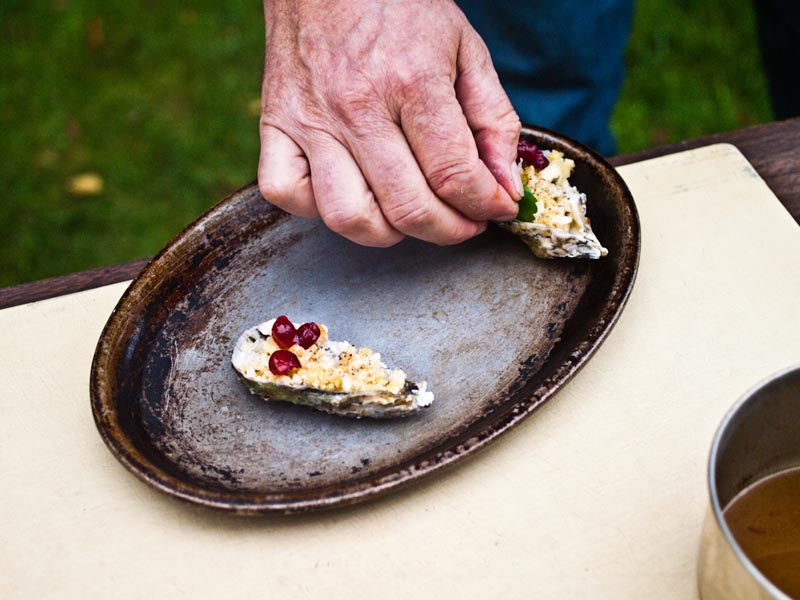Underneath the green canopy at the Wild Food challenge held at the Rod and Gun Club in Edgartown last Monday, Harbor View chefs Shaun Sells and Nathan Gould, dressed in sleek black uniforms, hovered over their chopping boards, quietly and meticulously slicing smoked striper. Nearby, 11-year-old Rose Herman and 10-year-old Violet Cabot drizzled a beach plum vinaigrette on their watercress salad to accompany a slice of acorn squash and a filet of bluefish.
“I caught the fish,” said Violet proudly. “And we picked the greens. The sorrel in West Tisbury and the watercress in Chilmark.”
Throughout the evening, 47 chefs, including professionals, amateurs and children worked side by side in the makeshift kitchen at the Rod and Gun club prepping, marinating, slicing, shucking and chilling everything from black bear sausage pizza to Cape Pogue scallops to Russian olive ice cream.
“It’s great to see the kids entering,” said Kevin Cromwell, owner of Detente Restaurant in Edgartown. “You gotta start there. Pretty soon they’ll be winning it.”
Three years ago Mr. Cromwell joined Wild Food challenge creators Bill and Sarah Manson in their hometown of Eastbourne, New Zealand at what would become the first challenge. The Mansons held a neighborhood barbecue with one rule: make a tasty dish using at least one wild ingredient.
“It just started as my wife and I noticed how many people in our community use wild food as part of their everyday food,” said Mr. Manson. “Everyone is always swapping different things, whether it’s snapper for venison or herbs for garden vegetables.”
The challenge was a success, and Mr. Cromwell asked the Mansons to bring it back to the Island.
And the Vineyard delivered. This year’s entrees included bay scallops, tangy Russian olives, juicy venison, squirrel and one of the judge’s favorites: mussels.
“That’s the first wild mussels dish we’ve had on the Island,” said judge Albert Lattanzi, owner of Lattanzi’s Restaurant.
“And part of that is going out and catching them,” said Mr. Manson.
Taste and presentation are main judging criteria, but points start to stack up for more wild and local ingredients, as well as the effort put into foraging, fishing, hunting or harvesting the ingredients. Emily Coulter’s acorn bread, for instance, started with acorns she gathered at home which she then washed, cracked, leached, baked and ground into flour. “It’s a technique from past times,” said Mr. Manson. “It is nice to see a resurgence of the humble acorn. It takes a bit of a process to make it digestible for humans.” Bay scallops may be more immediately digestible but still require gathering, shucking and preparing, whether served sashimi style or as scallop croquettes.
Over 100 people attended the event to watch and sample the wild food creativity of fellow Islanders, from creamy bluefish horns with choke cherry preserve, Island-inspired pho (Vietnamese soup) with homemade fish sauce aged from local squid, or a braised squirrel stuffed with puffball mushrooms.
There was also a squirrel pie and a knotweed pie with acorn crust.
While squirrel is obviously wild, many plants around the house can serve as wild food, too.
Knotweed was one of many invasive species that crept into the dishes. Others included clover, mint and sea beans.
“We want people out in their environment, understanding their food sources and resources and how to look after them,” said Mr. Manson.
The winner of the kid’s challenge, Madia Bellebuono, 10, entered cavatelli cooked with rabbit and bacon. The flour for her pasta was ground from lamb’s quarters seeds, and Madia skinned and boned the rabbit with the help of her parents.
“We started at about 10 o’clock this morning and the plan just progressed throughout the day,” said Madia.
Everett Whiting began foraging around the farm on Monday morning for the ingredients in his Island surf and turf dish: venison backstrap with acorn squash stuffed with hen of the woods, hazelnuts and cranberries, and topped with a Russian olive red wine reduction.
Harbor View executive chef Shaun Sells and sous chef Nathan Gould made an adventure out of the challenge, whipping up a display of fishes, meats, marmalades and condiments.
“We wanted to showcase all the wonderful things on the Vineyard,” said chef Gould, who moved here from the Virgin Islands. “I didn’t know this land, and I didn’t know what was here.”
The Harbor View team gathered and dehydrated sea salt from Edgartown, made pastrami from up-Island goose, and smoked stripe bass roe.
“Every fisherman was throwing out an excess of the fish and I didn’t know why,” said Chef Gould of the roe. “So I started smoking them.”
Chef Sells found ingredients for the Aquinnah blackberry mostarda while on an unrelated outing.
“I like to surf,” he said. “So I go check the surf. Pick some wild blackberries. Make a preserve.”
Meg Athearn, who with her husband Dan were the grand prize winners of the competition, said she and her daughter Clara collected sassafras leaves from around the house to make sassafras honey tea with Russian olive ice cubes.
“Clara helped me harvest because she knows how to spot them,” said Mrs. Athearn.
Their winning dish also included a salad of watercress with Katama grassland onions, sun chokes, candied sedge grass nuts with autumn olive reduction, served with a sedge grass nut-encrusted venison sirloin on a bed of caramelized onions with beach plum reduction, sun choke puree, wild-caught lobster and Quitsa scallops.
Runner-up Mike Winkelman represented the entire Island terrain in his dish, including smoked eel croquettes from Menemsha Pond, eggs from Aquinnah, dandelion greens from Oak Bluffs, homemade bacon from Grey Barn pork belly, all finished with curried sea water from Ink Well Beach, and served on a rock from Moshup beach.
“The guy has gone all over the Island, leaving literally no stone unturned,” said Mr. Manson.
Mr. Manson said he hoped the challenge helped people take note of the abundance of food in their surroundings, whether walking by a berry bush, weeding purslane in the garden or foraging for nuts.
“People are changing their minds about how they want to eat their food and treat their environment, and they are understanding their space and what is available.”











Comments
Comment policy »